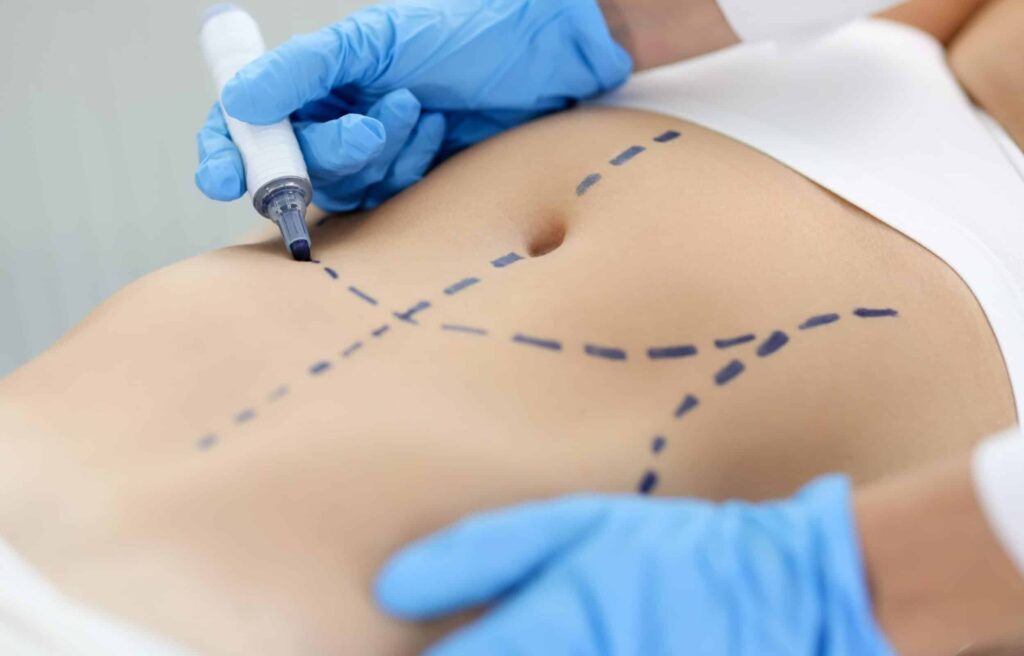In a world where self-confidence and self-image often go hand in hand, the quest for a more sculpted and toned midsection has become increasingly prevalent. Abdominoplasty, a surgical procedure to tighten and tone the belly, is getting more and more attention from those who want to look and feel better.
To shed light on this procedure, we contacted plastic surgeon Dr. Maíra, who shared her expertise and insights on abdominoplasty. So, together we will explain the principles of this surgery, differentiate it from liposuction, and break down the procedure step-by-step. We’ll also discuss a timeline for definite outcomes, risks, and safety measures.
Abdominoplasty: What Is It?
Many people who have experienced significant weight changes, such as gaining a lot and then losing it or going through pregnancy, often find themselves grappling with the issue of loose, sagging skin in their belly area. Unfortunately, this excess skin doesn’t respond well to traditional methods like diet and exercise. In such cases, abdominoplasty becomes a viable solution. This surgical procedure involves the removal of the surplus skin from the abdominal region, helping to restore a more toned and contoured appearance [1, 2].
While abdominoplasty is typically sought for cosmetic reasons, it can also have functional benefits. One of the key aspects of the surgery is the realignment and tightening of the rectus abdominis muscles.
“After weight gain or pregnancy, these muscles can become separated, a condition referred to as “abdominal diastasis”. The procedure corrects this problem by bringing the muscles back together, ultimately improving tone and strength in the abdomen.”
— Dr. Maíra
Abdominoplasty comes in different types, each suited to varying degrees of skin sagging and the specific appearance of the patient’s abdomen.

Here are the three main types of abdominoplasty:
- Mini abdominoplasty
This type of procedure is suitable for individuals with mild skin sagging. In such cases, removing a small amount of excess skin is adequate, and there’s no need to address abdominal diastasis. Importantly, the position of the navel remains unchanged during this surgery.
- Conventional abdominoplasty
The most commonly performed type of abdominoplasty; it involves the complete detachment of the skin. Beyond removing excess skin, this procedure also repositions the navel to its original location. Conventional abdominoplasty allows for a more significant volume of skin removal and includes the approximation of abdominal diastasis.
- Anchor abdominoplasty
Anchor abdominoplasty is reserved for individuals with an intense degree of skin sagging, often presenting significant lateral flaccidity. In such cases, a traditional incision is insufficient to address the issue. An additional cut in the middle of the abdomen is necessary, creating an anchor-shaped appearance on the abdomen.
Anchor abdominoplasty is generally recommended for extreme cases, such as patients who have lost a substantial amount of weight.
Abdominoplasty and Liposuction: What Are the Differences?
Abdominoplasty aims to remove excess skin from the belly area. Although it reduces some fat, this elimination is limited to the section of skin that is extracted during the surgery.
The key focus of abdominoplasty is getting rid of drooping skin, particularly after considerable weight loss or pregnancy.
“Any fat removal during abdominoplasty is an incidental outcome of the skin elimination, not the main purpose of the operation.”
— Dr. Maíra
In contrast, liposuction is a procedure specifically designed to target and remove excess fat deposits from various body areas. This surgical method is especially effective in addressing lateral fat on the abdomen, as well as in the back and other localized areas.

Based on this, patients must comprehend that abdominoplasty and liposuction have differing objectives.
Abdominoplasty chiefly eliminates skin, while liposuction aims to reduce fat and shape the body. Combining these techniques, when suitable, can produce thorough outcomes that reshape the abdominal region for a more natural and attractive appearance [3].
Step-By-Step Surgery Process
To help you fully understand the tummy tuck process, we’ll go through the steps from the first meeting with the surgeon to aftercare.
✔️ Initial consultation
The path to achieving a changed belly starts with the patient opting to meet with a plastic surgeon.
In this vital initial stage, the physician assesses the patient’s medical past and current state. This meeting allows the individual to express their objectives, make inquiries, and come up with the most appropriate plan.
✔️ Surgery preparation
To achieve good results from an abdominoplasty, patients need to prepare beforehand.
Dr. Maíra recommends reaching a healthy weight by eating well, staying active, and adopting good eating habits. It improves safety and increases the chances of success while decreasing the risk of problems.
However, if time is limited, it is recommended to allow a minimum of 2 months for preparation. For instance, if you smoke, it is crucial to quit during this period to reduce the risks associated with surgery. Additionally, focusing on maintaining a nutritious diet and healthy lifestyle habits will positively impact the surgical outcome.
✔️ Day of surgery
After choosing to have an abdominoplasty, the patient is checked in on the day of surgery. Typically, they are released the following day.
✔️ Post-operative care
The recovery process is a critical aspect of abdominoplasty.
Patients are fitted with a drain after the procedure, which remains in place for seven days. This helps eliminate excess fluid from the surgical area.
Additionally, patients are advised to wear elastic stockings to prevent thrombosis, and an anticoagulant medication may be prescribed to minimize the risk of blood clots.
✔️ Lymphatic drainage
A fundamental component of post-operative care is lymphatic drainage. Patients are monitored and receive post-operative care by a physiotherapist. These sessions help reduce swelling and promote healing.
✔️ Follow-up visits
Patients have regular check-ups every two weeks until their wound heals. They are further monitored for around a year post-surgery to ensure progress and achievement of the final outcome.

How Soon Will I Have a Definitive Result From Abdominoplasty?
A patient’s full recovery from abdominoplasty typically occurs within a month. During this period, the surgical wound closes, and the individual can resume their normal activities, including working and carrying light weights.
However, the real transformation takes time.
From three months post-surgery, patients can start to notice significant improvements in their abdominal area, and they can begin to engage in activities that might involve abdominal muscles.
How Many Kilos Will I Lose With Abdominoplasty?
Abdominoplasty is not primarily designed as a weight loss surgery, and individuals should not expect it to be a significant means of shedding kilos.
“In most scenarios, patients undergoing abdominoplasty do not witness significant weight loss in the traditional manner. Instead, the reduction is primarily attributed to the removal of the excess skin that is surgically excised during the procedure.”
— Plastic surgeon, Dr. Maíra
The key is to manage expectations when considering abdominoplasty. Although the surgery can yield a striking transformation in the look of the abdomen, it must not be viewed as a means for shedding pounds. Rather, it is a body contouring intervention that elevates the aesthetic appeal of the abdominal region.
Risks and Safety

While abdominoplasty can deliver transformative results, it’s important to acknowledge and address the potential complications that may arise during the recovery period. Here are some of them:
- Seroma and/or hematoma
These complications involve the accumulation of fluids (seroma) or blood (hematoma) beneath the skin at or near the surgical site. Both can potentially cause discomfort, delayed healing, and, in some cases, require medical intervention.
Proper post-operative care can help minimize the risk of seroma and hematoma formation. This includes:
- Wear recommended compression garments
- Avoid strenuous activities
- Maintain proper wound care and hygiene
- Scarring
While the type of sutures used is consistent across all patients, the way their skin heals can vary. Some patients develop thin, inconspicuous scars, while others may experience hypertrophic or keloid scarring, where the scar becomes thick and raised.
To improve the appearance of scars, various measures can be taken, such as using healing ointments or applying silicone tape.

- Blood clots
After surgery, there is a risk of blood clots forming in the legs, which can potentially travel to the lungs and cause a life-threatening condition known as pulmonary embolism. Surgeons often take measures to prevent this, such as prescribing blood-thinning medications and advising compression stockings for patients.
As we see, abdominoplasty, though generally considered safe, does carry certain inherent risks and factors that must be carefully considered. Therefore, patients must engage in a consultation with their surgeon to assess their specific needs and concerns.
Furthermore, it’s worth noting that ongoing advancements in surgical techniques and post-operative care options are continually enhancing the overall safety and efficacy of abdominoplasty [4].
The Verdict
Abdominoplasty, commonly known as a tummy tuck, is a cosmetic surgical procedure aimed at improving the appearance of the belly.
However, it’s important to understand that this isn’t a magic wand for weight loss; abdominoplasty primarily addresses excess skin and muscle laxity in the belly area. It can help individuals who have lost a significant amount of weight or have experienced pregnancy-related changes to regain a more toned and contoured body.
Also, keep in mind that abdominoplasty, similar to any surgery, has specific risks. Hence, people considering the procedure should talk to a certified plastic surgeon to explore their options and comprehend the process thoroughly.
FAQ
🧐 What is abdominoplasty?
Abdominoplasty, commonly known as a tummy tuck, is a surgical procedure performed to enhance the appearance of the belly area. It is typically done to remove excess skin, tighten muscles, and create a flatter, more toned abdomen.
❓ Is abdominoplasty a weight loss procedure?
No, abdominoplasty is not a weight loss surgery. The key focus of surgery is getting rid of drooping skin, particularly after considerable weight loss or pregnancy.
🔍 What are the potential risks and complications of abdominoplasty?
Like any surgical procedure, abdominoplasty carries some risks, including infection, scarring, blood clots, and seroma or hematoma formation. Patients should be aware of these risks and discuss them with their surgeon.
📌 How long is the recovery period after abdominoplasty?
Recovery time can vary, but most patients can return to light activity within a few weeks. Strenuous activities should be avoided for a more extended period — around three months. Full recovery may take a year, and patients should follow their surgeon’s post-operative instructions diligently.
References
- Staalesen T, Elander A, Strandell A, Bergh C. A systematic review of outcomes of abdominoplasty. J Plast Surg Hand Surg. 2012 Sep;46(3-4):139-44. doi: 10.3109/2000656X.2012.683794. Epub 2012 Jul 2. PMID: 22747350.
- Stuerz K, Piza H, Kinzl JF. The impact of abdominoplasty after massive weight loss: a qualitative study. Ann Plast Surg. 2013 Nov;71(5):547-9. doi: 10.1097/SAP.0b013e3182503b11. PMID: 23187713.
- Swanson E. Prospective clinical study of 551 cases of liposuction and abdominoplasty performed individually and in combination. Plast Reconstr Surg Glob Open. 2013 Sep 10;1(5):e32. doi: 10.1097/GOX.0b013e3182a333d7. PMID: 25289226; PMCID: PMC4174197.
- Rangaswamy M. Minimising complications in abdominoplasty: An approach based on the root cause analysis and focused preventive steps. Indian J Plast Surg. 2013 May;46(2):365-76. doi: 10.4103/0970-0358.118615. PMID: 24501473; PMCID: PMC3901918.




